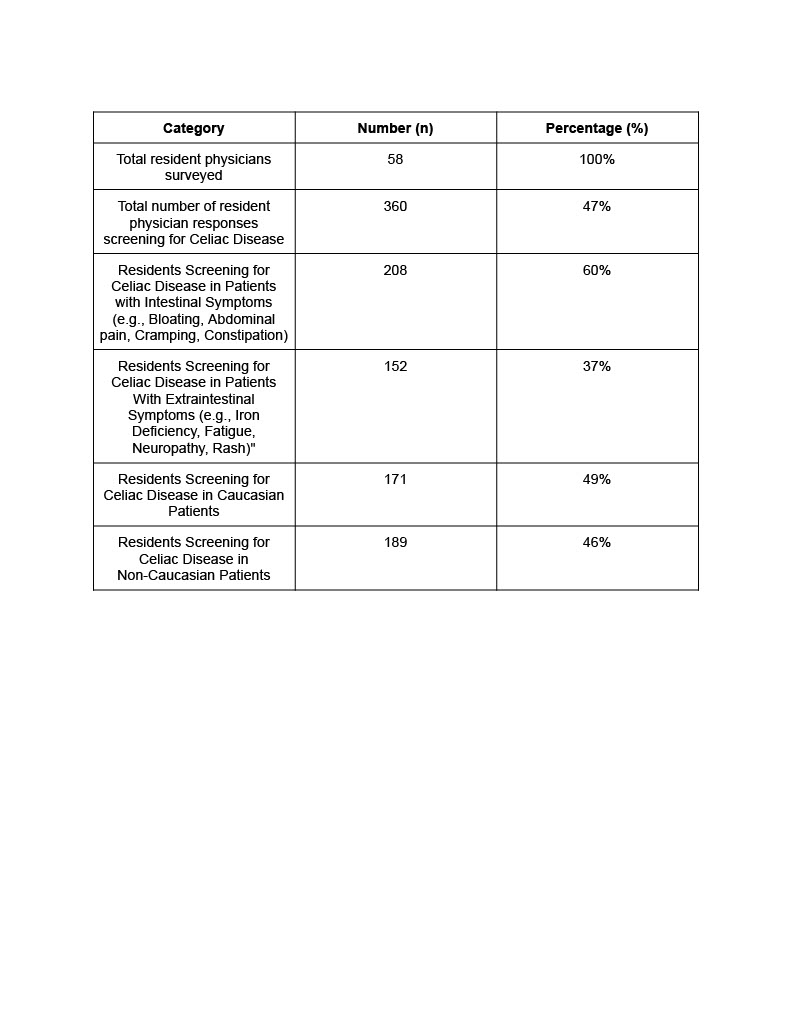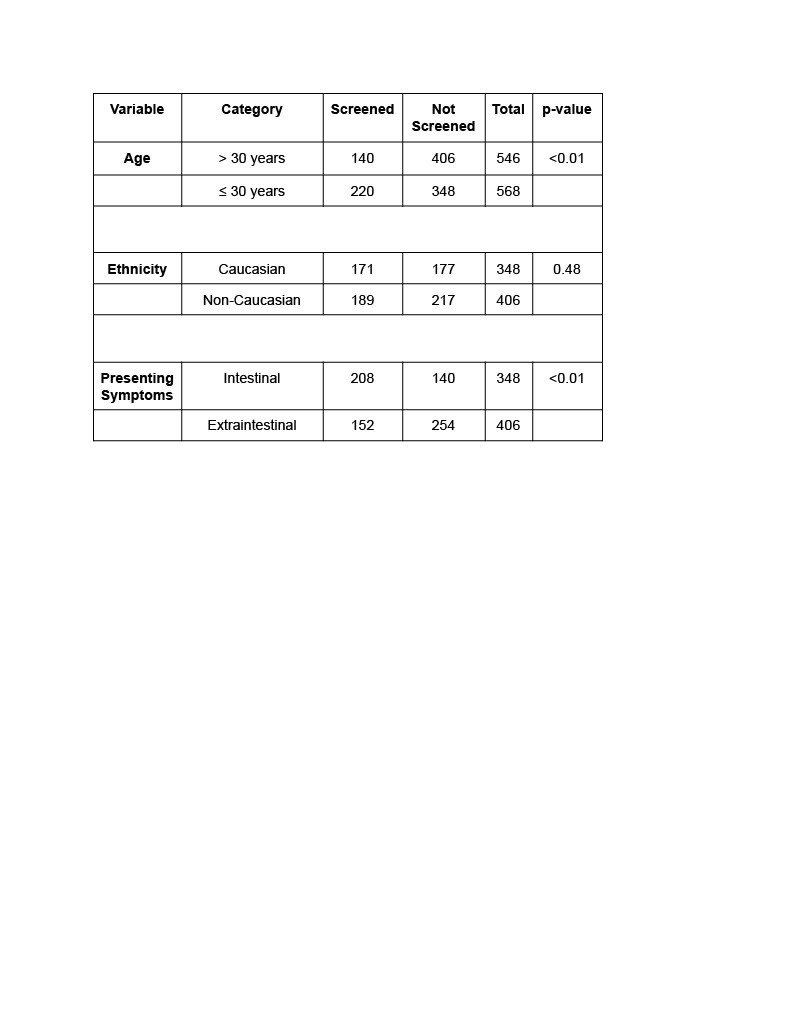Monday Poster Session
Category: Small Intestine
P4050 - Hidden in Plain Sight: Exploring Diagnostic Biases in Celiac Disease
Monday, October 27, 2025
10:30 AM - 4:00 PM PDT
Location: Exhibit Hall

Carlos G. Diola, MD (he/him/his)
Icahn School of Medicine at Mount Sinai
New York, NY
Presenting Author(s)
Carlos G. Diola, MD, Christopher Cao, MD
Icahn School of Medicine at Mount Sinai, New York, NY
Introduction: Celiac disease (CD) is a chronic autoimmune disorder triggered by gluten ingestion, resulting in enteropathy. Its highly variable clinical presentation often complicates diagnosis, especially in cases with nonclassical or extraintestinal symptoms. Globally, the prevalence of CD is approximately 1.4%, and CD can be seen in all individuals irrespective of age, ethnicity or sex. Classically, CD has been felt to affect younger Caucasian patients with gastrointestinal symptoms, which may contribute to missed diagnoses in other populations.
Methods: This survey study evaluated whether internal medicine residents at an urban tertiary care program in New York City considered CD in their differential given a series of question stems that varied based on patient age, ethnicity, and symptomatology. A 13-item questionnaire was developed to present a range of clinical vignettes reflecting diverse symptom types (gastrointestinal vs. extraintestinal) and patient demographics (Caucasian, Asian, Hispanic, Black) and patient age (older or younger than 30 years old). Associations between screening decisions and patient variables were analyzed using the Pearson Chi-squared test.
Results: Among 58 resident responses, screening was significantly more likely for individuals with intestinal symptoms (59.77%)—such as bloating, abdominal pain, and cramping—than for extraintestinal symptoms (37.43%) like neuropathy or iron deficiency anemia, with the exception of pruritic rash (p ≤ 0.01). Patients under the age of 30 were also significantly more likely to be screened (p < 0.01). Screening rates were slightly higher for Caucasian patients (49.13%), compared to non-Caucasian patients (46.55%), although this difference was not statistically significant (p = 0.48).
Discussion: These findings suggest that CD may be underrecognized in patients with atypical or extraintestinal presentations and in older patients. Although no significant disparities were found by ethnicity, the trend highlights the need for continued awareness of CD's varied manifestations across populations. In a diverse urban setting like New York City, it is encouraging that resident physicians consider screening across varying ethnicities. Larger studies are needed to further characterize potential screening biases and to inform educational efforts that promote broader recognition of CD

Figure: Table 1. Celiac Disease screening among resident physicians who responded to the survey (n=58)

Figure: Table 2. Association between Celiac Disease screening rates and patient characteristics based on Chi-Square Analysis
Disclosures:
Carlos Diola indicated no relevant financial relationships.
Christopher Cao indicated no relevant financial relationships.
Carlos G. Diola, MD, Christopher Cao, MD. P4050 - Hidden in Plain Sight: Exploring Diagnostic Biases in Celiac Disease, ACG 2025 Annual Scientific Meeting Abstracts. Phoenix, AZ: American College of Gastroenterology.
Icahn School of Medicine at Mount Sinai, New York, NY
Introduction: Celiac disease (CD) is a chronic autoimmune disorder triggered by gluten ingestion, resulting in enteropathy. Its highly variable clinical presentation often complicates diagnosis, especially in cases with nonclassical or extraintestinal symptoms. Globally, the prevalence of CD is approximately 1.4%, and CD can be seen in all individuals irrespective of age, ethnicity or sex. Classically, CD has been felt to affect younger Caucasian patients with gastrointestinal symptoms, which may contribute to missed diagnoses in other populations.
Methods: This survey study evaluated whether internal medicine residents at an urban tertiary care program in New York City considered CD in their differential given a series of question stems that varied based on patient age, ethnicity, and symptomatology. A 13-item questionnaire was developed to present a range of clinical vignettes reflecting diverse symptom types (gastrointestinal vs. extraintestinal) and patient demographics (Caucasian, Asian, Hispanic, Black) and patient age (older or younger than 30 years old). Associations between screening decisions and patient variables were analyzed using the Pearson Chi-squared test.
Results: Among 58 resident responses, screening was significantly more likely for individuals with intestinal symptoms (59.77%)—such as bloating, abdominal pain, and cramping—than for extraintestinal symptoms (37.43%) like neuropathy or iron deficiency anemia, with the exception of pruritic rash (p ≤ 0.01). Patients under the age of 30 were also significantly more likely to be screened (p < 0.01). Screening rates were slightly higher for Caucasian patients (49.13%), compared to non-Caucasian patients (46.55%), although this difference was not statistically significant (p = 0.48).
Discussion: These findings suggest that CD may be underrecognized in patients with atypical or extraintestinal presentations and in older patients. Although no significant disparities were found by ethnicity, the trend highlights the need for continued awareness of CD's varied manifestations across populations. In a diverse urban setting like New York City, it is encouraging that resident physicians consider screening across varying ethnicities. Larger studies are needed to further characterize potential screening biases and to inform educational efforts that promote broader recognition of CD

Figure: Table 1. Celiac Disease screening among resident physicians who responded to the survey (n=58)

Figure: Table 2. Association between Celiac Disease screening rates and patient characteristics based on Chi-Square Analysis
Disclosures:
Carlos Diola indicated no relevant financial relationships.
Christopher Cao indicated no relevant financial relationships.
Carlos G. Diola, MD, Christopher Cao, MD. P4050 - Hidden in Plain Sight: Exploring Diagnostic Biases in Celiac Disease, ACG 2025 Annual Scientific Meeting Abstracts. Phoenix, AZ: American College of Gastroenterology.
